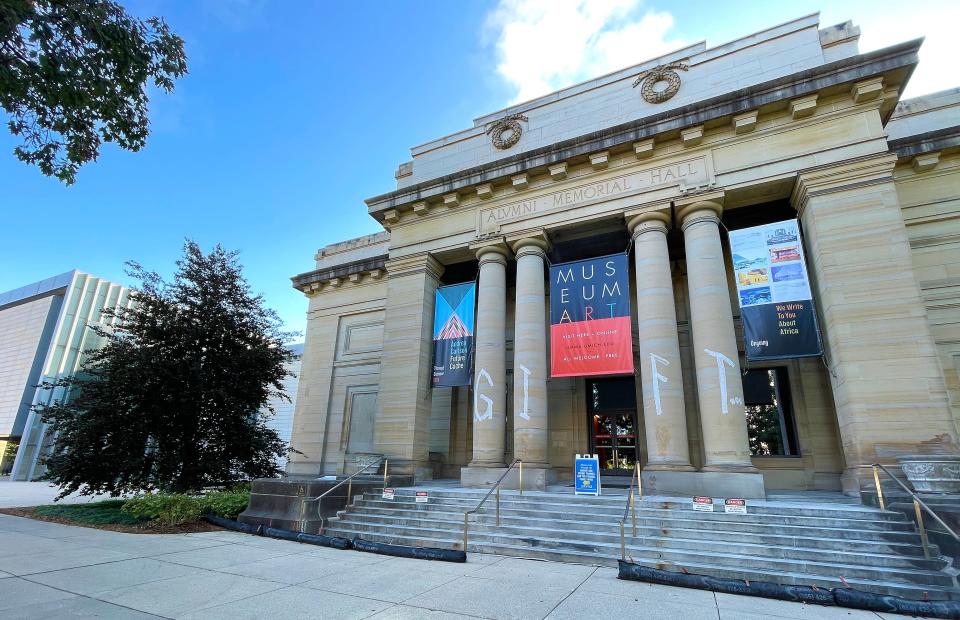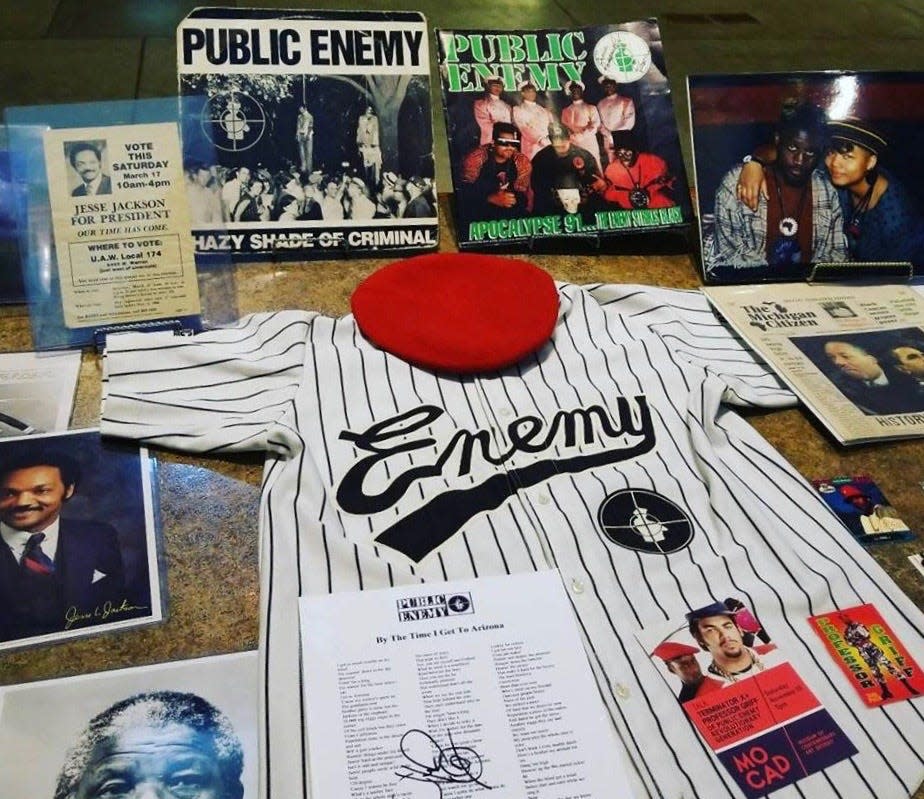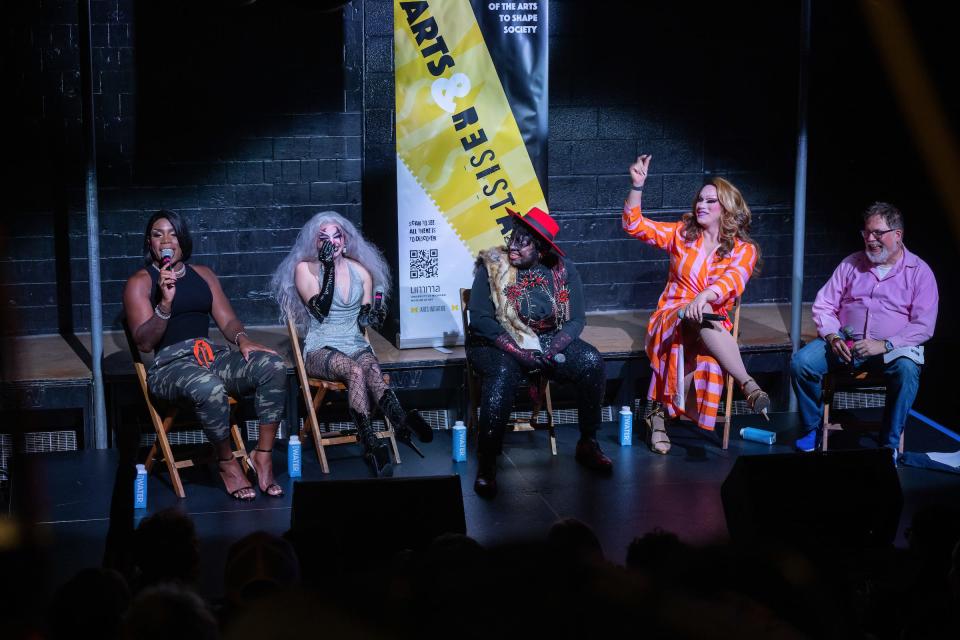University of Michigan pushes the envelope with Arts & Resistance theme semester
- Oops!Something went wrong.Please try again later.
- Oops!Something went wrong.Please try again later.
- Oops!Something went wrong.Please try again later.
Long before a University of Michigan panel discussion was supposed to begin, professor Lawrence La Fountain-Stokes noticed people lining up to guarantee a seat in the audience.
When he reminded them the event wasn’t scheduled to start for more than an hour, La Fountain-Stokes says they didn't budge. "They looked at me like: ‘We don’t even know what you’re talking about. We just want to be inside. It’s very important!,’” says the chair of U-M's American studies department, who moderated the discussion.

In the halls of academia, attending a panel discussion is sort of like eating your oatmeal. It can be good for you, but it usually doesn’t generate that much excitement.
But this event, held a couple of weeks ago, was different. It featured a reality competition star, Monet X Change, a past winner of “RuPaul’s Drag Race,” along with several local drag performers who were there to talk about drag in artistic, political and personal terms.
It also had an untraditional setting. “Drag as Resistance: Conversation & Performance” took place at Necto Nightclub, a longtime hub for the LGBTQ community and the site of Pride nights every Friday since 1984.
Nothing about this seminar could be called ordinary. Then again, U-M is attempting something intentionally provocative with its Arts & Resistance theme for the fall semester.
Arts & Resistance aims to spotlight the role of the creative arts in challenging the forces of oppression and changing the world for the better. It is designed to reach all corners of Ann Arbor, from students to residents, and the satellite campuses in Flint and Dearborn and beyond. The calendar of what's happening encompasses more than 100 courses, more than 50 programs and events and numerous visiting artists.
Co-organized by the U-M Museum of Art, the U-M Arts Initiative and the the U-M College of Literature, Science, and the Arts, the semester kicked off in September and runs through December. One of its goals is to demonstrate how the arts can have a positive impact on society.
“They actually can address the most urgent and challenging issues that we’re facing," says Mark Clague, interim executive director of the U-M Arts Initiative, which launched in 2019 and is involved in its biggest project yet with Arts & Resistance.
Putting together a theme semester is an enormous task for an institution as huge and fragmented into various fiefdoms as U-M, so it's not surprising that the journey from concept to reality took a while. The idea was born more than two years ago, while the planning process lasted about a year and a half, according to Jim Leija, deputy director for public experience and learning at the U-M art museum.
During the middle of the pandemic, as work was underway on two future museum exhibitions, chief curator Laura De Becker and Leija began thinking of ways to use the shows as tentpoles for a much larger dialogue on art and how it connects to resistance, resilience and social justice.
One of the exhibits is “Hear Me Now: The Black Potters of Old Edgefield, South Carolina,” which centers on works created by African American potters in the decades around the Civil War. The other, “Cannupa Hanska Luger: You’re Welcome,” arose form a collaboration with the Luger, the artist, and Monument Lab, a nonprofit art and history studio in Philadelphia dedicated to having a dialogue on the past, present and future of monuments.
Luger, who was born on North Dakota’s Standing Rock Reservation and is a member of the Three Affiliated Tribes of Fort Berthold and is Mandan, Hidatsa, Arikara and Lakota, has contributed a bold statement with his three-part exhibit, particularly the exterior element titled "GIFT."
In September, Luger painted the letters G, I, F, and T on the four front columns of the museum building in white porcelain clay slip, a liquid clay mix. The word "gift" refers to the 1817 Treaty of Fort Meigs, in which the Ottawa, Chippewa and Potawatomi tribes ceded land to the University that later was sold to found its endowments, according to the U-M Heritage Project.
A few days after adding the letters, Luger and his team kept painting until the historic façade of the museum (formerly the Alumni Memorial Hall, built in honor of fallen students and faculty from the Civil War and Spanish-American War) was covered with white clay, which will erode over time with the help of rain, sun and snow.
As the museum describes, the project "responds to and challenges the University of Michigan’s origin story and the stewardship of the land it occupies" and conveys Luger’s message that “whiteness is a concept, and though it has created many catastrophic systemic issues and problems, it is essentially a function of perception. GIFT asks people to perceive whiteness differently—it is thin, temporary, and it is slipping away.”
“GIFT” is part of a growing effort to encourage people to think about monuments, history and memory in a more complex manner. For instance, like so many other civic buildings (not to mention the bulk of the monuments in Washington, D.C.), the U-M museum’s classical architecture, which hearkens back to ancient Greece and Rome, sends a message at odds with the university’s real timeline.

“As an Indigenous person, seeing that architecture on this landscape, I’m, like, 'This country is not that old,'” says Luger, who will be the featured guest Thursday at the Penny Stamps Distinguished Speaker Series at the Michigan Theater.
Where “GIFT” challenges the narrative of the very beginnings of U-M, another part of Arts & Resistance turns to the music that's popular with today's students. On Nov. 6, Khalid el-Hakim will bring his Black History 101 Mobile Museum for a look at hip-hop, which turns 50 this year, through the prism of social and political movements.
The show has toured extensively through the United States and moves on after this to Oregon, Washington, Colorado and beyond. It uses 150 artifacts to trace the bonds between hip-hop music and causes like the campaign to end apartheid in South Africa, the Million Man March, the presidential campaign of Barack Obama and the Black Lives Matter movement.
More than 30 years ago, el-Hakim started collecting objects and cultural memorabilit that told the centuries-long story of Black Americans. In 1995, the Detroit native and former Detroit Public Schools teached founded the mobile museum. Since then, he has traveled with exhibits drawn from his archives to more than 40 states and 500 sites, winning awards for its portable educational messages.
El-Hakim cites the work of famed street artist Shepard Fairey as one of Michigan’s connections to the story of hip-hop and social movements. In 2006, when Detroit mourned the death of two prominent hip-hop artists, J. Dilla and Proof of D-12, Fairey created memorial posters for each performer.

Those posters ended up being the template for the iconic “Hope” poster for the 2008 Obama campaign. Says el-Hakim: “Young people saw hip-hop represented in that image of Barack Obama. We saw something that resonated with us. It was a nod to our culture. It was hip. It was young. It was fresh.”
El-Hakim, who now teaches a class on hip-hop music at Western Michigan University, says hip-hop is about resistance at its roots. “It started in the Bronx in the 1970s. Like most youth cultural music, it's rebelling against the establishment. Rock 'n' roll did the same thing. Blues did the same thing. But I think hip-hop, at its best, challenges people to address social ills."
At the "Drag as Resistance" panel discussion, drag artists spoke about many topics, including the campaign waged since spring 2023 by Republican state legislators to restrict or ban their performances, says La Fountain-Stokes, a professor of Spanish, Latina/o, and women's and gender studies.
“The possibility that you could be arrested for appearing in drag in public on the street or performing close to children was really outrageous because people have been performing in drag as long as the human race has been around. It is a legitimate artistic expression. It is a legitimate form of employment."
The panel featured Monet X Change, the first double crown winner on “RuPaul’s Drag Race,” along with U-M undergrad Pinball McQueen, popular Washtenaw Country drag legend Jadein Black, who has faced harassment and threats for her activism, and Riley Poppyseed, a drag king from Columbus, Ohio.

La Fountain-Stokes has unique insight into what it means to be a drag artist. Since 2010, the prominent scholar has performed in drag occasionally as the character Lola Von Miramar. He says that while he was working on a book about drag in Puerto Rico, some of the artists he was researching thought it would be hilarious for him to dress up and make a video with them. That led to his appearance on the “Cooking with Drag Queens” series on YouTube.
“It really transformed my research experience, because then I went from being a devoted fan and scholar to an actual participant, to being able to experience … not only what it means to dress up and how it transforms you and your interaction with the audience but also the risk entailed, the danger from being subjected to homophobia and transphobia to snide comments from colleagues,” he says.
This week, La Fountain-Stokes was among those honored at U-M’s annual faculty awards dinner. He was there for winning the 2023 University of Michigan Press Book Award for “Translocas: The Politics of Puerto Rican Drag and Trans Performance.”
As envelope-pushing as Arts & Resistance is proving to be, has there been any concern about going too far?
"There definitely has been some introspection, like, is this too much?,” says Clague. “There has also been a sense of trying to be bold and to do something provocative ... something meaningful." Which, if you think about it, is exactly what the arts and resistance are all about.
To find out more about the U-M Arts & Resistance theme semester and its events, go to the University of Michigan Museum of Arts official site.
Contact Detroit Free Press pop culture columnist Julie Hinds at jhinds@freepress.com.
This article originally appeared on Detroit Free Press: Arts & Resistance is provocative theme of University of Michigan project

